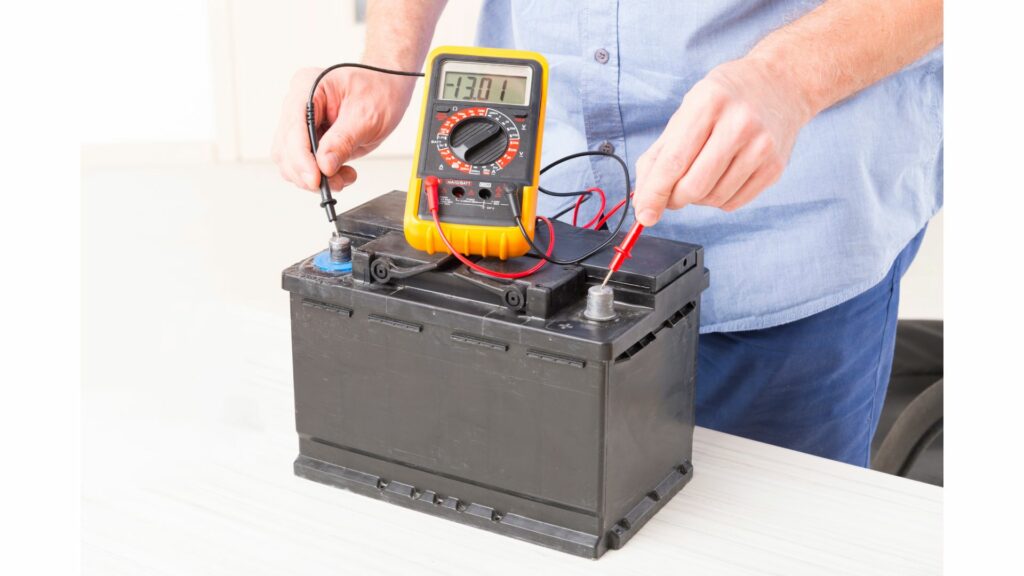You shouldn’t buy a 6V battery unless you know for a fact that it can meet your equipment’s electrical demands. That means identifying the battery’s amperage and comparing it to the target load. But what is a 6V battery’s amperage?
I expect a 6V battery to provide 2- 2.5 amps.
But you can’t take this information at face value, and here’s why. You find the amperage when you divide the power by the voltage. The power is typically represented by the watts. You need at least two of these variables to find the third.
For instance, you get the wattage when you multiply the amps by the voltage. You can’t find the watts if the amps and voltage are absent. The same is true for the amps. Voltage doesn’t tell you anything about the amount of electricity the battery will provide.
You must account for the battery type and resistance. Otherwise, you’re out of luck.
How Do You Check Amps On A 6 Volt Battery?
Batteries have labels that reveal the specs. Look for the voltage and amp hours on this label or in the manual. Whether or not your battery indicates the amps as well depends on the brand.
These labels can fade over time, which is why many people keep multimeters on hand. Follow these steps to test your battery:

1). Switch the multimeter on and set it to Ah. If you know the battery’s Ah, use it to refine the Ah setting on the multimeter.
2). Connect the black wire from the multimeter to the battery’s negative terminal.
3). Run the red wire to the battery’s positive terminal.
4). Look at the readings. If you know the Ah already, the readings should match the Ah printed on the label.
Naturally, this will create some confusion. After all, you want to know the amperage, not the Ah (Amp Hours). The amps represent the current. They reveal the amount of electricity flowing per second. The amp hours reveal the battery’s capacity. They will show you the number of amps the battery will provide in an hour.
Unfortunately, the amp hours are the best you can expect from a multimeter. You can get the wattage if you multiply the voltage by the Ah. This is encouraging because watts/volts will give you the amps.
In other words, measuring the Ah with a multimeter can indirectly reveal the amps. But you can find the Ah on the label or by contacting the manufacturer. Until you identify variables like the load and battery type, you cannot accurately determine a 6-volt battery’s amps.
How Many Hours Does A 6 Volt Battery Last?
You find the number of hours a 6V battery lasts by looking at the capacity in Ah. Every battery has a specific capacity. You find the Ah by looking at the label. The manufacturer will tell you everything you need to know.
For instance, some 6V batteries have a capacity of 1Ah. Others have a capacity as high as 100Ah. But the hours it takes to discharge the battery depend on the load. What do you want to operate?
How many amps will your equipment draw? You can’t tell how many hours a battery will last without finding the load’s electrical draw.
Some 6V batteries will last hours because you attached a small load that consumes the battery’s charge slowly. Others will drain the batteries in less than the 45 minutes mentioned above because their electrical draw is too high.
Once again, you need more information. For instance, you can calculate the discharge rate of this 6V battery from David Instruments because it has 12 amp hours.
This information is more than enough to guide you. This 6V Trojan battery is similar because it mentions a rated capacity of 420 amp hours. A 6V battery with a capacity of 420Ah will deliver 420 amps for one hour if the load current is 1A.
As you can see, you can’t determine the discharge rate without the amp hours and load amps. The voltage won’t tell you anything.
How Many Watts In A 6 Volt Battery?
Watts is voltage X amps. You know the volts (6V), but what about the amps? You can’t proceed without the amperes. Because these are batteries, the wattage is not your primary focus. You need the watt-hours. But again, this means multiplying the volts by the amp hours.
For instance, Rolls Battery has given the example of a 6V battery with 445Ah. Multiplying 6V by 445AH gives you 2,670 watts. Fortunately, the manufacturer will tell you the amp hours. With this information, you can find the watts.
Don’t expect every 6V battery to offer the same watts, amps, amp-hours, and watt-hours.
How Many Milliamps In A 6 Volt Battery?
Milliamps measure the flow of current. One milliamp is one-thousandth of an amp (0.001A). It is comparable to the difference between meters and millimeters. Multiplying the amps by 1000 will give you the milliamps.
Therefore, you can’t find the milliamps without first determining the amps. But again, the manufacturer may reveal this information. There is no standard amperage for 6V batteries. If you ask a local technician to tell you the milliamps of your 6V battery, they will ask you to specify factors like the load amps, battery type, amp hours, and the like.
If you’ve seen a guide specifying the milliamps of a 6V battery, don’t be so quick to apply that information to your situation. Those milliamps are only applicable to that particular 6V battery. Don’t expect that 6V battery’s specs to match your 6V battery’s attributes.
What Is The Equivalent To A 6V Battery?
You can find 12V batteries with a similar Ah as 6V batteries. The reverse is also true. You can find 6V batteries that work in a device that prefers 12V batteries. Check the device you want to operate for the specs it needs. Even though the manual specifically demands 6V batteries, you can experiment with other voltages if the other specs match.
Where Are 6V Batteries Used For?
6V batteries are like any other battery. They can work in a variety of fields. For instance:
- You can add a 6V battery to an RV system. If the system prefers 12V, combine two 6V batteries to achieve your desired results.
- 6V batteries can run a golf cart. Usually, golf carts use 48 volts. But you can apply eight 6V batteries to run the cart.
- 6V batteries will operate a child’s toy. It only takes two of them to achieve this objective.
- You can connect 6V deep cycle batteries to a solar system. 12V is the norm. However, 6V can also work if you use enough batteries. Solar batteries store the energy the solar panels collect.
As you can see, 6V batteries are versatile, which is why you can’t pin their amperage down based solely on the voltage. 6V batteries can work in any arena if the amperes and amp hours are sufficient.
You’ve also noticed that people frequently use 12V and 6V in the same settings. 12V has six cells, while 6V has only three cells. Common sense will tell you to prioritize 12V as the stronger option.
However, many people prefer 6V because it is smaller, lighter, and more convenient to store. You can charge and discharge 6V batteries more frequently because they have thicker plates. This guarantees a longer lifespan.
At What Voltage Is A 6 Volt Battery Dead?
According to Foot Print Hero, a 6V lead acid battery is dead at 5.81V. For a 6V flooded lead acid battery, that figure falls slightly to 5.79V at 0 percent. From the tables on the platform, you can see the capacity of each battery depending on the voltage.
If the 6V battery is fully charged, expect a reading of 6.3 or 6.4V. In other words, the voltage is slightly higher than 6V.
Related post:


Thank you for this clear explanation.
I mechanically restore antique cars and typically they run a 6 volt battery.
I am currently building a “rescue distributor” to configure a 6 volt system independent of the car’s 6 volt system except to turn the crank to start the car, at which point the “rescue distributor” fires the points/plugs and fills the condenser, thus presenting me with another diagnostic tool. That is, if the car runs on a “rescue distributor” meaning it’s firing independent of the cars existing electrical system, and if I am doing this because the car would not run as originally electrically configured, then my problem with the car is electrical, not gas flow or compression. I am using four 1.5 volt D batteries in series for power.